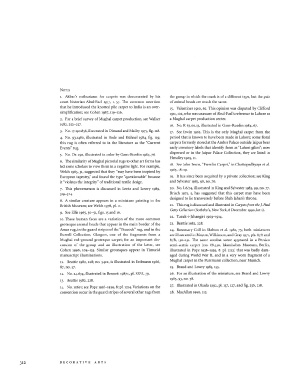Page 328 - Decorative Arts, Part II: Far Eastern Ceramics and Paintings, Persian and Indian Rugs and Carpets
P. 328
NOTES
1. Akbar's enthusiasm for carpets was documented by his the group in which the mask is of a different type, but the pair
court historian Abul-Fazl 1977, i, 57. The common assertion of animal heads are much the same.
that he introduced the knotted pile carpet to India is an over- 15. Valentiner 1910, 62. This opinion was disputed by Clifford
simplification; see Cohen 1987,119-126. 1911,102, who was unaware of Abul-Fazl's reference to Lahore as
2. For a brief survey of Mughal carpet production, see Walker a Mughal carpet production center.
1982, 252-257. 16. No. R 63.00.13, illustrated in Gans-Ruedin 1984, 67.
3. No. 17.190.858, illustrated in Dimand and Mailey 1973, fig. 128. 17. See Irwin 1962. This is the only Mughal carpet from the
4. No. 93.1480, illustrated in Bode and Kiihnel 1984, fig. 119; period that is known to have been made in Lahore; some floral
this rug is often referred to in the literature as the "Current carpets formerly stored at the Amber Palace outside Jaipur bear
Events" rug. early inventory labels that identify them as "Lahori gilim"; now
dispersed or in the Jaipur Palace Collection, they are listed in
5. No. Or. 292, illustrated in color by Gans-Ruedin 1984, 76.
Hendley 1905,11.
6. The similarity of Mughal pictorial rugs to other art forms has
led some scholars to view them in a negative light. For example, 18. See John Irwin, "Fremlin Carpet," in Chattopadhyaya et al.
Welch 1963, 31, suggested that they "may have been inspired by 1965,18-19.
European tapestry," and found the type "questionable" because 19. It has since been acquired by a private collection; see King
it "violates the integrity" of traditional textile design. and Sylvester 1983, 98, no. 76.
7. This phenemenon is discussed in Lentz and Lowry 1989, 20. No. 1.6/74, illustrated in King and Sylvester 1983, 99, no. 77.
319-324- Brisch 1975, 5, has suggested that this carpet may have been
designed to lie transversely before Shah Jahan's throne.
8. A similar creature appears in a miniature painting in the
British Museum; see Welch 1978, pi. 11. 21. This rug is discussed and illustrated in Carpets from the J. Paul
Getty Collection (Sotheby's, New York, 8 December 1990, lot i).
9. See Ellis 1965, 50-51, figs. 15 and 16.
22. Tuzuk-i-Jahangiri 1909-1914.
10. These human faces are a variation of the more common
grotesque animal heads that appear in the main border of the 23. Beattie 1982, 228.
Ames rug, in the guard stripes of the "Peacock" rug, and in the 24. Rosemary Grill in Skelton et al. 1982, 75; both miniatures
Burrell Collection, Glasgow, one of the fragments from a are illustrated in Binyon, Wilkinson, and Gray 1971, pis. 87A and
Mughal red-ground grotesque carpet; for an important dis- 876, 130—131. The same combat scene appeared in a Persian
cussion of the group and an illustration of the latter, see semi-scenic carpet (no. 88.330, Islamisches Museum, Berlin,
Cohen 1996, 104-135. Similar grotesques appear in Timurid illustrated in Pope 1938-1939, 8: pi. 1213) that was badly dam-
manuscript illuminations. aged during World War II, and in a very worn fragment of a
11. Beattie 1982, 228; no. 5422, is illustrated in Erdmann 1966, Mughal carpet in the Purrmann collection, near Munich.
87, no. 57. 25. Brand and Lowry 1985,155.
12. No. 24.674, illustrated in Bennett 1987C, pi. XXVI, 39. 26. For an illustration of the miniature, see Brand and Lowry
13. Beattie 1982, 228. 1985, 93, no. 58.
14. No. 10615; see Pope 1938-1939, 8: pi. 1214. Variations on the 27. Illustrated in Okada 1992, pi. 137,127, and fig. 256, 218.
convention occur in the guard stripes of several other rugs from 28. MacAllan 1990,112.
312 D E C O R A T I V E A R T S

